Kulaks, agents of foreign intelligence, Trotskyists, counter-revolutionaries and other imaginary enemies of the people were either dead or dying in labor camps. Nothing threatened Stalin's power anymore, and it was time to end the massive terror. It was enough to… speed up the murder.
It might seem that the Stalinist orgy of mass torture, murder and deportation to labor camps was the work of a madman. However, this would not be a justified assessment. As historian Nikolai Ivanov emphasizes in his latest book, "The Polish operation" was not [...] the product of a sick mind unlimited as an absolute ruler, but the result of his cold calculation and common sense. These words can be applied to all the great terror. It had specific goals, and its limits were determined by Stalin's will and interest.
In 1938, mass terror had an increasingly negative impact on the condition of the USSR. It resulted in the disorganization of the Red Army, railway inefficiency, falling coal mining and a reduction in industrial production, including military production. It was hard to innovate when any engineer feared a lethal sabotage charge.
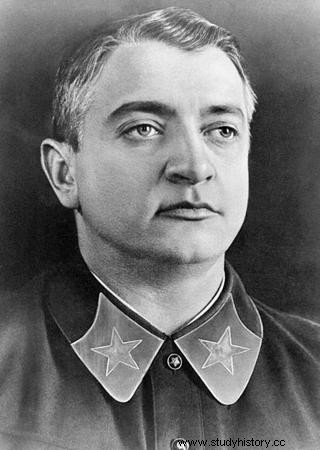
The "Great Terror" seriously wiped out the officer cadre of the Red Army. Marshal Mikhail Tukhachevsky was also among the victims.
Thousands of complaints about NKVD abuses, assurances of innocence and pleas and pleas for mercy were sent to the party, and partly to Stalin's desk. Nothing threatened the position of the Leader, and the terror was out of control. It was time to quit.
Even more terror
The machine of violence, however, developed so much that it was not easy to stop. For example, the date of completion of the Polish operation was postponed several times. Although it was initially assumed to last three months until November 20, 1937, it did not end until November of the following year. As late as August 1, 1938, as many as 100,000 were still pending. matters of potential agents. Although everyone was well aware of the total fictitiousness of the charges, there was no intention of releasing the accused from arrests and torture rooms. The Stalinist logic was simple:the enemies of the people had to be eliminated more effectively.
On September 15, 1938, the discharge of the described traffic jam was entrusted to special "threes" who could freely decide about the fate of those arrested without any actual control. Each of them was made up of the head of the local NKVD, the local prosecutor and the highest party official in the region. These "threes" worked in the sweat of their brow. One of them, operating in the Zhytomyr Oblast, was able to sentence up to 400 people to death during the day.
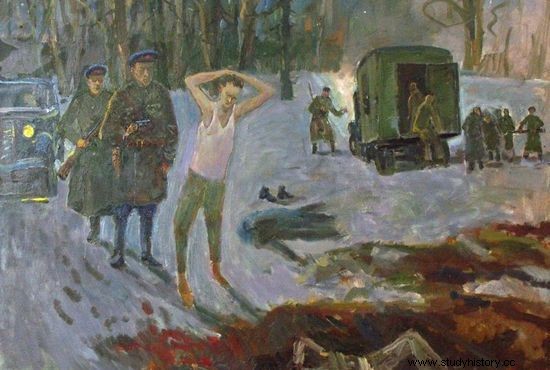
The NKVD "troops" could murder even several hundred people a day. Everything "for the good of the Country of Soviets."
No wonder that over 105,000 were spent in less than two months. judgments, of which 72 thousand. people faced the highest punishment. As a result, on November 17, the "trio" were liquidated, the NKVD was placed under the control of the prosecutor's office (ie the party), and the great terror ended. 10,000 people survived in Leningrad. people already condemned to death because executions were suspended.
Terror yes, abuse no
Stalin did not have enough blood yet. When the false accused were dead, it was fair to admit that a small number of them were actually innocent. Of course, it was necessary to find those responsible for these "abuses". People who faithfully followed their leader's orders joined his enemies. Although the dictator himself recommended in writing the beatings of prisoners and set the minimum number of arrests and sentences, now the fulfillment of his orders has proved to be an act of treason. As early as January 1938, during the plenary session of the Central Committee of the Communist Party of the Soviet Union (b), Stalin described cases of making fictitious charges or extorting confessions through torture.
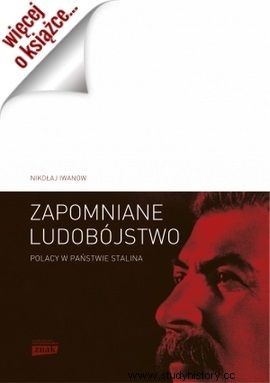
The head of the NKVD, Nikolai Yezhov, who himself took part in the torture of prisoners, had to pretend to be surprised. Most of the "excesses" took place in the Caucasus, so a special inspection was carried out there. She demonstrated the existence of an alleged plot to discredit the "iron drug." There could be only one effect:the purge of the local NKVD and the execution of its boss, Piotr Bulach.
Soon the noose also began to tighten around the neck of Yezhov himself. First, his deputy, Leonid Zakowski (owned by Henryk Sztubis), was arrested and shot. At the end of August 1938, Lavrentiy Beria became the new deputy of the "bloody dwarf", who vigorously started to "clean up" the NKVD.
In the following months, hundreds of high-ranking police officers were arrested, thus replacing almost the entire top of the police station. Yezhov fell into disgrace - in January 1939 even his brother was arrested.
Beria's men came for the "iron drug" in April 1939 and took such care of it that quickly admitted to the plot to kill Stalin and the entire Bolshevik leadership. In the course of the annual "investigation" it also turned out that Jeżow was both a Polish and German spy and ... a homosexual organizing fanciful orgies.
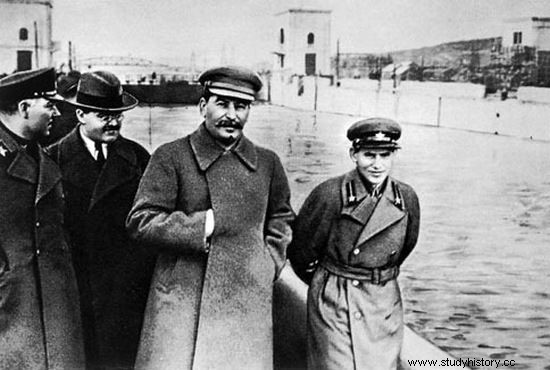
Yezhov (first from the right) paid for his eagerness in carrying out the criminal orders of Stalin. It will also disappear from this photo.
From a Russian he became a Lithuanian, and from the son of a worker a descendant of the brothel owner and dancer (which in the communist nomenclature meant simply a prostitute). Finally, it was intended to deliberately allow the total collapse of the terror apparatus under its control, in order to spark a rebellion against Soviet power. Needless to say, it was all just nonsense.
During the trial, Yezhov withdrew his testimony and claimed that he himself "got rid" of 14,000 chekists guilty of excesses for which he was to be responsible. “I demand that Stalin be informed that I have fallen victim to a coincidence, to which enemies, who felt threatened by me, could have lowered their hands. Tell Stalin I will die with his name on my lips "- he said in court. All in vain, of course. He was shot in the first days of February 1940.
Apart from Yezhov himself, 345 more people belonging to his associates and family, including women and children, were executed. His memory was obliterated, so that he was even removed from the photos in which he stood next to Stalin. The dictator himself was said to have said after the war:“ Yezhov is a pig! A demoralized man. […] He murdered many innocents. We shot him for that. ”
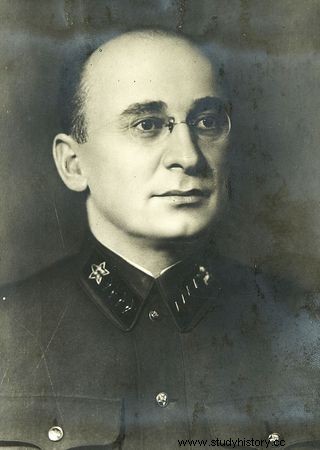
Lavrenty Beria. Successor to the "bloody dwarf" who was to become (partly wrongly) a symbol of the "great terror".
What was it all for? Nikolai Ivanov aptly sums it up:
Stalin consciously created a system of universal interdependence in the course of the "great terror". Party and state officials, NKVD employees at all levels - all involved in the implementation of the tasks of terror - slowly became its hostages. If necessary, Stalin could accuse them of the crimes committed under his instructions. Both the "Polish operation" and other repressive actions of the "great terror" almost always ended with accusing all terrorists and their execution.
Yezhov became a scapegoat, and his death not only lifted the blame from Stalin's shoulders, but also gave him peace. He knew that his control over the NKVD remained complete and unchallenged.
Sources:
- Nikolai Ivanov, Forgotten genocide. Poles in the state of Stalin. "Polish operation" 1937–1938 , Znak Horyzont, Krakow 2015.
- Jörg Baberowski, Red terror. History of Stalinism , PWN, Warsaw 2009.
- Same, Absolute terror , Prószyński i S-ka, Warsaw 2014.
- Arch Getty, Oleg W. Naumov, Yezhov. Iron fist of Stalin , Amber, Warsaw 2008.
- Timothy Snyder, Bloodlands. Europe between Hitler and Stalin , Świat Książki, Warsaw 2011.
